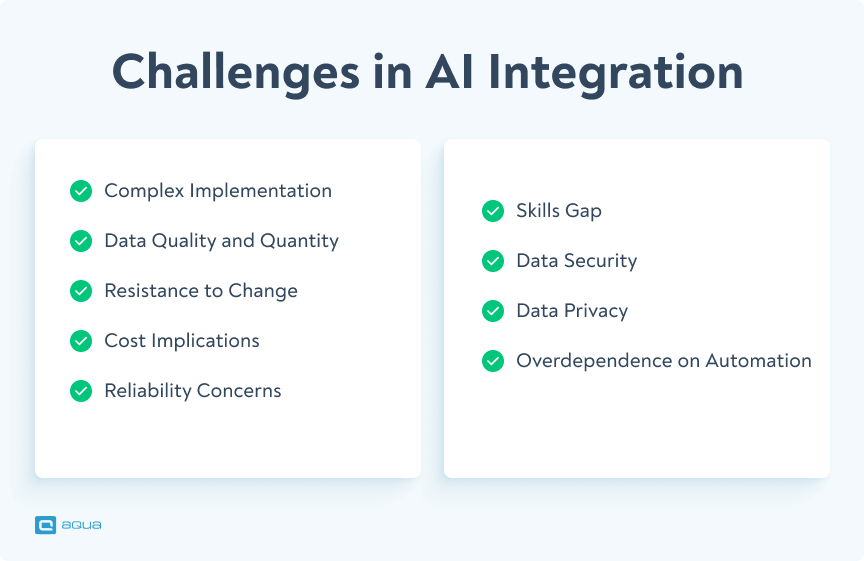Benefits of integrating AI into traditional test management
As organisations strive to enhance testing efficiency and reduce errors, integrating AI into traditional test management presents itself as a groundbreaking solution. For example, aqua has implemented a “Test Management” module, which included a 4-fold validation of the test scenarios through automated testing for one of its partners “Spacewell Germany”. As a result, the software’s high quality has become a decisive sales argument and competitive advantage.
But what are other unique reasons why AI is drawing such industry attention? Here are a few of them:
- Enhanced Test Coverage: AI can scan vast amounts of software data to identify areas that might have been missed during traditional testing. It can generate test cases based on software requirements, ensuring a detailed examination of every feature.
- Predictive Analysis: Using historical data, AI can anticipate potential defects or vulnerabilities. This proactive approach means teams can address issues before they occur, ensuring a smoother development process.
- Faster Bug Detection: Your AI testing tools now fix themselves when apps change – no more manually updating broken scripts every sprint. They spot UI shifts and API tweaks in real-time, then adapt on their own. Pick one flaky test that breaks monthly and throw it at a self-healing platform for two weeks. You’ll quickly avoid the common trap of trying to convert your entire suite at once.
- Continuous Learning: Here’s the thing about AI test management: you’re essentially getting a crystal ball that learns from every bug your team finds. Think about it: each time your tests catch something, the AI gets smarter about spotting patterns. It starts flagging those sketchy areas in your codebase where issues love to hide. The predictive piece is where things get interesting. Instead of blindly running your entire regression suite, you’ll know exactly which 20% of tests will catch 80% of potential issues in your next release.
- Cost Efficiency: By reducing manual intervention and errors, AI can substantially reduce the costs associated with testing. Organisations can channel these savings into other innovative ventures.
- Data-driven Insights: AI doesn’t just operate on a binary pass-or-fail system. It can provide in-depth insights and reasons for test outcomes, helping teams understand not just where the issue lies but why.
As you can see, integrating AI into your traditional test management can significantly automate quality control processes and enable faster testing. To witness this in action, it’s time to try aqua testing software. Test Management System aqua provides revolutionary AI-powered features such as instant test case and test data generation, automatic analysis and prioritisation of test cases, duplicate detection, and much more. According to feedback from our customers, harnessing these capabilities allows them to save at least 12.8 hours per user every week and achieve cost reductions of up to 72%.
Discover the ultimate solution for enhancing your QA with the power of AI
AI Integration with Popular Test Management Tools: What's Available Now
The AI-powered test management space has grown fast, and you’ve got solid options right now. Tools like aqua cloud packs real AI punch: auto test case and test data generation, visual bug-reporting, and smart reporting that actually makes sense.
Some tools are free or open source (perfect for smaller projects), while commercial platforms give you the heavy lifting: scalability, deep analytics, and smooth CI/CD integration. You need to start by mapping your current workflow before you pick a tool. Does it play nicely with your existing defect tracking? Can your team actually use it without a PhD?
Watch out for vendor lock-in, though. Teams using AI-enhanced tools report efficiency in test maintenance, but only when the tool fits their actual process, not the other way around. Your best first step? Download a trial and run it against your messiest test suite. If it can handle that chaos, you’re golden.
Challenges in AI Integration
The combination of Artificial Intelligence with traditional test management opens a whole road filled with advantages. However, the path to this integration is also filled with several crucial obstacles. The shift from established testing paradigms to AI-driven methods can be somewhat compared to a trembling stone at the base of your castle. Here’s a breakdown of the most common challenges that you might face head-on when shifting to an AI:
- Complex Implementation Process: Introducing AI into an existing traditional test management system can be a technical challenge. It is one of the most common problems, as the significant changes done in the platform infrastructure demand expertise in both testing and AI domains.
- Data Quality and Quantity: AI thrives on data. The effectiveness of AI-driven tests is largely contingent on the quality and quantity of data available for training. Poor data can lead to inefficient test results.
- Resistance to Change: As with the introduction of any innovative technology, there can be resistance from teams accustomed to conventional testing methods. This can stem from a lack of understanding, scepticism about AI’s capabilities, or a natural aversion to changing long-standing practices.
- Cost Implications: While AI promises cost savings in the long run, the initial investment required for tools, training, and infrastructure can be substantial. For some organisations, especially smaller ones, this can be a deterring factor.
- Reliability Concerns: Relying on AI for critical tests can be daunting. Teams might question: “What if the AI misses a crucial bug?” The inherent ‘black box’ nature of some AI algorithms can raise these concerns, leading to trust issues.
- Overdependence on Automation: There’s a risk of teams becoming overly reliant on AI, sidelining the vital human element in testing. Human testers might best catch some nuances and contextual issues, emphasising the importance of maintaining a balance.
- Skills Gap: The integration demands a new skill set. There’s a pressing need for testers who understand AI or for AI specialists who grasp the intricacies of software testing, leading to a potential skills gap in many organisations.
- Data Security: Ensuring data security through the AI-driven testing process is paramount. Unsecured data flows can lead to data breaches, which can bring you in big trouble.
- Data Privacy: Similar to data security, data privacy is essential in AI integration. Utilising third-party platforms like ChatGPT for testing may not be an option due to data privacy concerns, as it’s not permissible to share sensitive data with external platforms.

“AI significantly bolsters the automation aspect of QA testing, moving from a combination of manual and automatic processes to entirely automatic testing processes."
Solutions and Best Practices
While there are a few crucial challenges in integrating AI with traditional test management, they’re not so fearsome. By adopting certain practices and approaches, organisations can ensure a seamless and efficient integration of AI into their testing processes. Thus, here are some best practices that can guide this integration:
- Pilot Programs: Before a full-fledged implementation, conduct pilot programs. This allows teams to gauge the effectiveness of the AI tool, understand potential challenges, and make necessary adjustments, minimising risks.
- Invest in Training and Upskilling: Address the skills gap by investing in training programs. Equipping testers with AI knowledge and vice versa, you cultivate a team adept at navigating both domains.
- Prioritise Data Hygiene: Ensure the data fed into the AI systems is of high quality. Regularly clean, update, and audit your datasets to optimise the training and functioning of AI models.
- Hybrid Testing Approach: Instead of an outright replacement, adopt a hybrid approach. Combine the strengths of AI-driven automation with the nuances of human-driven testing. This ensures comprehensive test coverage and captures the intricacies that AI might overlook.
- Transparent Communication: Address resistance to change by maintaining transparent communication. Highlight the benefits, address concerns, and involve teams in the integration process. When employees feel included and informed, they’re more likely to embrace the change.
- Choose the Right Tools: Not all AI-driven test tools are created equal. Identify tools that align with your testing requirements, budget, and infrastructure. For instance, the test management tool by aqua is designed to align with modern demands, offering a harmonious blend of traditional and AI-driven testing features.
- Regular Feedback Loops: Establish regular feedback mechanisms. AI systems thrive on feedback, continuously learning and improving. This enhances test accuracy and ensures that the system remains aligned with evolving testing requirements.
- Benchmarking and Continuous Monitoring: Regularly benchmark the AI system’s performance against traditional methods to ensure it’s delivering the expected outcomes. Continuous monitoring helps in the early identification of issues, ensuring swift remediation.
- Collaborate with Experts: Consider collaborating with industry experts or hiring consultants to integrate AI in testing successfully. Their insights and experiences can be invaluable in navigating potential pitfalls.
Proactive Quality Assurance: The Human and AI Partnership
AI is flipping test management on its head – taking you from reactive bug hunts to smart, proactive quality checks.
Identifying your three most failure-prone modules from the last six months should be your first goal. Feed this data to your AI tools and watch them suggest targeted test suites for similar components.
The magic happens when you stop fighting AI and start working with it. Let the machines handle repetitive regression testing while you focus on the creative stuff – exploratory testing, edge case hunting, and those ‘what if a user does something completely unexpected’ scenarios that no algorithm can predict.
Remember, the best results come from teams who view AI as the junior tester, not the senior one. You’re still the one making the strategic calls and interpreting those weird edge cases that pop up.
When you can predict problems instead of just reacting to them, quality becomes baked into your process rather than bolted on at the end.
Conclusion
Integrating Artificial Intelligence with traditional test management is not just a past trend at all, but rather a dynamic approach that promises to redefine software testing. AI combines automation, precision, and adaptability, addressing many pain points associated with manual and traditional methods.
However, as with any significant shift, this integration has certain challenges. From technical complexities to resistance to change, modern organisations have to address them. Whether it’s adopting a hybrid testing approach, investing in the right tools like aqua’s test management solution, or fostering continuous learning – with the right strategies, the challenges can not only be managed but turned into growth opportunities.
For businesses, the message is clear: Embrace AI’s potential, equip your teams with the software like aqua test management tools and strategies needed, and you’re not just keeping pace with the industry – you’re leading it. As aqua’s guiding principle suggests, it’s time to “take away the pain of testing” and embark on a journey of innovation, efficiency, and unparalleled quality.
Streamline your whole testing process


















